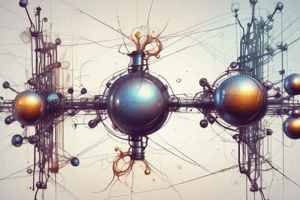Podcast
Questions and Answers
What characterizes a simple displacement reaction?
What characterizes a simple displacement reaction?
- A less reactive element replaces a more reactive element.
- It involves the breaking of chemical bonds in all cases.
- A more reactive element displaces a less reactive element from a compound. (correct)
- The reaction occurs spontaneously without any conditions.
In the general displacement reaction represented as A + BC → AC + B, what must be true for the reaction to occur?
In the general displacement reaction represented as A + BC → AC + B, what must be true for the reaction to occur?
- Element C must be a liquid.
- Element A must be more reactive than element B. (correct)
- Both A and B must be metals.
- Element A must be less reactive than element B.
Which of the following is an example of a displacement reaction?
Which of the following is an example of a displacement reaction?
- CaCO3 → CaO + CO2
- 2H2 + O2 → 2H2O
- Zn + 2Cl2 → ZnCl4
- Cu + 2AgNO3 → 2Ag + Cu(NO3)2 (correct)
What does the activity series indicate about metals?
What does the activity series indicate about metals?
What must happen when a nonmetal is involved in a displacement reaction?
What must happen when a nonmetal is involved in a displacement reaction?
What happens when metals react with dilute acids?
What happens when metals react with dilute acids?
Which of the following reactions is an example of a double displacement reaction?
Which of the following reactions is an example of a double displacement reaction?
What is observed during the reaction of metals with dilute acids?
What is observed during the reaction of metals with dilute acids?
Which metals are incapable of displacing hydrogen from dilute acids?
Which metals are incapable of displacing hydrogen from dilute acids?
In a precipitation reaction, what is formed?
In a precipitation reaction, what is formed?
Which of the following is NOT a characteristic of a neutralization reaction?
Which of the following is NOT a characteristic of a neutralization reaction?
What type of reaction is 2Al + 6HCl → 2AlCl3 + 3H2?
What type of reaction is 2Al + 6HCl → 2AlCl3 + 3H2?
Which of the following compounds is produced when zinc reacts with dilute sulfuric acid?
Which of the following compounds is produced when zinc reacts with dilute sulfuric acid?
What is produced when a metal oxide reacts with a dilute acid?
What is produced when a metal oxide reacts with a dilute acid?
Which of the following statements correctly describes the purpose of antacids?
Which of the following statements correctly describes the purpose of antacids?
An example of a neutralization reaction is:
An example of a neutralization reaction is:
Which type of oxide is produced through the thermal decomposition of metal carbonates?
Which type of oxide is produced through the thermal decomposition of metal carbonates?
What type of bonds do non-metal oxides have?
What type of bonds do non-metal oxides have?
Which substance can be used to neutralize wasp stings?
Which substance can be used to neutralize wasp stings?
Which of the following is NOT a characteristic of acidic oxides?
Which of the following is NOT a characteristic of acidic oxides?
Which of the following forms metal oxides?
Which of the following forms metal oxides?
What color change is observed when copper reacts with silver nitrate?
What color change is observed when copper reacts with silver nitrate?
Which metal forms a reddish-brown deposit when reacting with copper sulfate?
Which metal forms a reddish-brown deposit when reacting with copper sulfate?
What is the observation when zinc reacts with lead nitrate?
What is the observation when zinc reacts with lead nitrate?
What is the characteristic flame color of sodium during its reaction with cold water?
What is the characteristic flame color of sodium during its reaction with cold water?
Metals below hydrogen in the reactivity series cannot displace which element?
Metals below hydrogen in the reactivity series cannot displace which element?
What is produced during the hot water reaction of magnesium with steam?
What is produced during the hot water reaction of magnesium with steam?
What happens to the blue solution when aluminum reacts with copper sulfate?
What happens to the blue solution when aluminum reacts with copper sulfate?
What is the correct equation for the reaction of potassium with cold water?
What is the correct equation for the reaction of potassium with cold water?
Which of the following oxides is classified as an acidic oxide?
Which of the following oxides is classified as an acidic oxide?
What happens when a basic oxide reacts with water?
What happens when a basic oxide reacts with water?
Which of the following statements about amphoteric oxides is true?
Which of the following statements about amphoteric oxides is true?
How do acidic oxides affect litmus paper?
How do acidic oxides affect litmus paper?
Which of the following oxides is an example of a neutral oxide?
Which of the following oxides is an example of a neutral oxide?
What is the product when zinc oxide (ZnO) reacts with hydrochloric acid (HCl)?
What is the product when zinc oxide (ZnO) reacts with hydrochloric acid (HCl)?
Which oxide turns phenolphthalein solution pink?
Which oxide turns phenolphthalein solution pink?
What characteristic do amphoteric oxides exhibit regarding litmus paper?
What characteristic do amphoteric oxides exhibit regarding litmus paper?
Flashcards
Single Displacement Reaction
Single Displacement Reaction
A chemical reaction where a more reactive element kicks out a less reactive one from a compound.
Reactivity Series
Reactivity Series
A list of metals arranged in order of their reactivity, from most reactive to least reactive.
Principle of Single Displacement
Principle of Single Displacement
A more reactive element will displace a less reactive element from a compound. This only happens if the element doing the swapping is more reactive.
Metallic Displacement
Metallic Displacement
Signup and view all the flashcards
Nonmetallic Displacement
Nonmetallic Displacement
Signup and view all the flashcards
Metal + Dilute Acid Reaction
Metal + Dilute Acid Reaction
Signup and view all the flashcards
Displacement Reaction
Displacement Reaction
Signup and view all the flashcards
Metal + Acid Reaction Reactivity
Metal + Acid Reaction Reactivity
Signup and view all the flashcards
Double Displacement Reaction
Double Displacement Reaction
Signup and view all the flashcards
Precipitation Reaction
Precipitation Reaction
Signup and view all the flashcards
Neutralization Reaction
Neutralization Reaction
Signup and view all the flashcards
Precipitation
Precipitation
Signup and view all the flashcards
Acid + Metal oxide → Salt + water
Acid + Metal oxide → Salt + water
Signup and view all the flashcards
Neutralization
Neutralization
Signup and view all the flashcards
Antacid
Antacid
Signup and view all the flashcards
Acid + Metal hydroxide → Salt + water
Acid + Metal hydroxide → Salt + water
Signup and view all the flashcards
Oxides
Oxides
Signup and view all the flashcards
Acidic Oxides
Acidic Oxides
Signup and view all the flashcards
Basic Oxides
Basic Oxides
Signup and view all the flashcards
Direct Combination of Metals and Oxygen
Direct Combination of Metals and Oxygen
Signup and view all the flashcards
What happens during a single displacement reaction with metals?
What happens during a single displacement reaction with metals?
Signup and view all the flashcards
What happens in the Copper and Silver Nitrate reaction?
What happens in the Copper and Silver Nitrate reaction?
Signup and view all the flashcards
What happens in the Iron and Copper Sulfate reaction?
What happens in the Iron and Copper Sulfate reaction?
Signup and view all the flashcards
What happens in the Zinc and Lead Nitrate reaction?
What happens in the Zinc and Lead Nitrate reaction?
Signup and view all the flashcards
What happens in the Magnesium and Copper Sulfate reaction?
What happens in the Magnesium and Copper Sulfate reaction?
Signup and view all the flashcards
What happens when highly reactive metals react with cold water?
What happens when highly reactive metals react with cold water?
Signup and view all the flashcards
What happens when metals react with hot water or steam?
What happens when metals react with hot water or steam?
Signup and view all the flashcards
Which metals cannot displace hydrogen from water?
Which metals cannot displace hydrogen from water?
Signup and view all the flashcards
Acid anhydride formation
Acid anhydride formation
Signup and view all the flashcards
Basic anhydride formation
Basic anhydride formation
Signup and view all the flashcards
Amphoteric Oxides
Amphoteric Oxides
Signup and view all the flashcards
Neutral Oxides
Neutral Oxides
Signup and view all the flashcards
Litmus Paper
Litmus Paper
Signup and view all the flashcards
Phenolphthalein
Phenolphthalein
Signup and view all the flashcards
Study Notes
Simple Displacement Reactions
- Chemical reactions where a more reactive element displaces a less reactive element from a compound are called displacement reactions. Also known as substitution or single displacement reactions.
- The general equation for a displacement reaction is: A + BC → AC + B
- The reaction only occurs if element A is more reactive than element B.
Reactivity Series of Metals
- The reactivity series arranges metals in decreasing order of their reactivity.
- Highly reactive metals are at the top of the series.
- More reactive elements can displace less reactive elements from their compounds.
Examples of Displacement Reactions (Page 2)
- Copper and Silver Nitrate: Copper displaces silver
- Iron and Copper Sulphate: Iron displaces copper
- Zinc and Lead Nitrate: Zinc displaces lead
- Magnesium and Copper Sulphate: Magnesium displaces copper
More Examples (Page 3)
- **Metals + Cold Water:**Highly reactive metals like sodium and potassium react vigorously, producing hydrogen gas.
- Metals + Hot Water: Less reactive metals like magnesium react with hot water or steam, forming metal oxides and releasing hydrogen gas.
- Metals + Dilute Acids: Metals react with dilute acids (like HCl or H2SO4) releasing hydrogen gas. More reactive metals react more rapidly.
Double Displacement Reactions
- A reaction where two ionic compounds exchange ions to form two new compounds.
- One product of the reaction is often an insoluble solid (precipitate).
- AB + CD → AD + CB
Neutralization Reactions
- A reaction between an acid and a base, producing a salt and water.
- Examples using acids (dilute HCl, HNO3, H2SO4) and metal oxides/hydroxides.
Applications of Neutralization
- Antacids neutralize excess stomach acid.
- Toothpastes neutralize acids created by food particles in the mouth, preventing cavities.
- Fertilizers adjust soil acidity to support plant growth.
Oxides
- Compounds formed when an element reacts with oxygen.
- Some oxides produce acids when combined with water (acidic oxides), while others produce bases (basic oxides)
- Amphoteric oxides exhibit both acidic and basic properties.
Studying That Suits You
Use AI to generate personalized quizzes and flashcards to suit your learning preferences.




